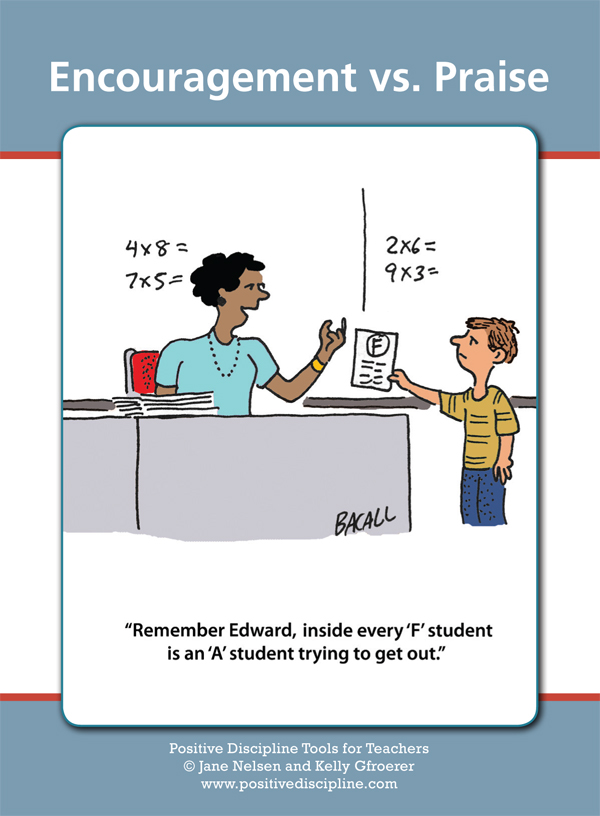by Dr. Kelly Gfroerer and Dr. Jane Nelsen, authors of Positive Discipline Tools for Teachers Book and the Positive Discipline Teacher Tool Cards
So, what is the difference between encouragement and praise? Praise teaches dependency on external feedback (I’m “okay” if you like what I do, and I feel badly if you don’t like what I do), while encouragement teaches internal validation, (I use self-evaluation to determine how I feel about what I do). When you praise students you put the spotlight on the student and when you walk away you take the spotlight with you. When you encourage students, your words go much deeper and hopefully stir up internal motivation that is long lasting.
The challenge is that many students like praise—especially if they have not experienced the differences. Recently in an Early Childhood and Development course for high school seniors, the concept of encouragement vs. praise was introduced, and the students immediately piped in with how much they loved praise from their parents and teachers. Who wouldn’t? It feels good to be validated by others. But like too much candy, too much praise can be unhealthy by creating dependence on others and lack of faith in one’s self.
Praise can also create a sense of competition among students. A preschool teacher just last week shared an example that illustrates how praise promotes comparisons (and competition), rather than working hard because it feels good. Her students were working on puzzles around the room, and when one student finished he brought the puzzle to her to show his work. She fell into the trap we all do so easily and said, “Wow, great job!” Immediately, she had three other Pre-K students around her asking her if she liked their work.
Unlike Praise, Encouragement helps students focus on effort, progress, and specifics of the job at hand. In the puzzle example, encouraging words might be: “I can see on your face you enjoy puzzle work,” or “I noticed you really working hard on your puzzle.” These encouraging statements help promote enjoyment in doing the work or putting forth effort rather than seeking adult approval.
Many teachers find just a simple tweak of words can make a huge difference in their students’ perseverance when things get tough. Changing “I like” to “I notice” is one easy shift from praise to encouragement. You can also encourage self-evaluation by saying, “I would like to hear what you think first.”
Encouragement places the focus on effort and process, rather than adult approval or appraisal. The long term effect of encouragement is that your students will be more independent, motivated, and self-evaluative. Here are some more examples of how you can use encouragement in your classroom:
- You figured out how to do that.
- You did it.
- You are learning how to tie those shoelaces. Last week you had trouble getting them tied, but this week you did it without a problem.
- Tell me how you did it.
- I see that you are working hard.
- This is hard for you, but you are sticking with it.
- You searched your mind and came up with something new.
We don’t mean to make you feel paranoid about praise, but encourage you to notice this week how often you use praise statements and then think of alternative encouraging statements. Understanding the difference between praise and encouragement can make a big difference in the classroom.
Carol Dweck’s research provides support for this important Positive Discipline Tool for Teachers. In Dweck’s studies she shows how praise can have a negative impact on motivation and learning. At Columbia University, and now at Stanford, Dweck has systematically studied praise across many developmental age groups (preschool to graduate school). Dweck reports that students who were praised for being smart when they accomplished a task later chose easier tasks. These students did not want to risk making mistakes. On the other hand, children who were encouraged for their efforts chose more challenging tasks when given choices. Focusing on effort and the process rather than outcome or teacher approval is key. Watch an example of this with 5th graders and learn more about Dweck’s research.


No Comments yet!